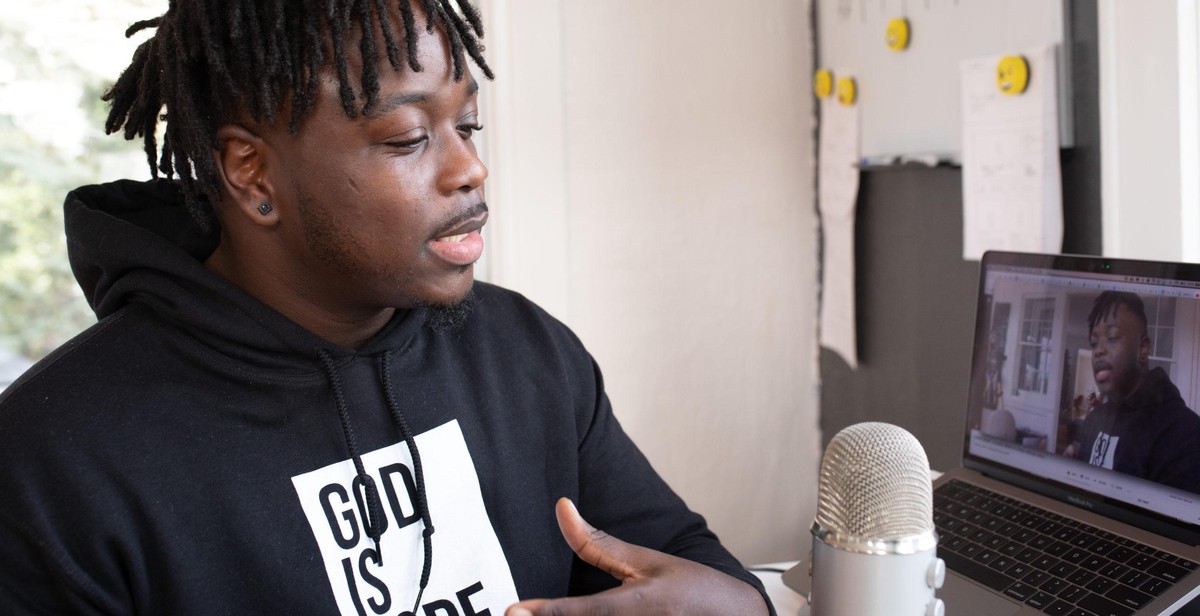How to Create a Captivating Storytelling Podcast: An Introduction
With the rise of digital media, podcasting has become a popular form of entertainment and information sharing. Podcasts are an excellent way to connect with an audience and convey your message through storytelling. Storytelling podcasts are particularly popular because they allow listeners to escape into a world of imagination and emotion.
Why Podcasting is Important for Storytelling
Podcasting provides an opportunity to tell stories in a unique way. Unlike traditional forms of media, podcasts allow for a more intimate connection with the audience. Listeners can engage with the content on a personal level, and hosts can create a community around their podcast. Additionally, podcasts are accessible to a global audience, making it possible to connect with people from all over the world.
When it comes to storytelling podcasts, the possibilities are endless. From true crime to fiction, podcasts offer a platform for all types of stories. As a result, podcasting has become an important tool for storytellers looking to reach a wider audience.
In this article, we will explore how to create a captivating storytelling podcast that will engage and entertain your audience. We will cover everything from choosing a topic to recording and editing your podcast. By the end of this article, you will have the tools you need to create a successful storytelling podcast.
Step 1: Plan Your Podcast
Creating a captivating storytelling podcast requires careful planning and preparation. The first step to creating a successful podcast is to plan it properly. Here are some tips on how to plan your podcast:
Identify Your Target Audience
The first step in planning your podcast is to identify your target audience. Who do you want to reach with your podcast? What are their interests and needs? Once you have identified your target audience, you can tailor your content and style to appeal to them. This will help you attract and retain listeners.
Choose a Topic and Theme
Once you have identified your target audience, you need to choose a topic and theme for your podcast. What do you want to talk about? What is your main message? Your topic and theme should be relevant to your target audience and interesting enough to keep them engaged. You can choose a broad topic or a specific niche, but make sure it’s something you’re passionate about and knowledgeable about.
Create an Outline for Your Podcast
Before you start recording, create an outline for your podcast. This will help you stay organized and focused. Your outline should include a clear introduction, main points, and a conclusion. It should also include any guests you plan to have on your show and any questions or topics you want to cover. Having a detailed outline will help you stay on track and ensure that your podcast flows smoothly.
By following these steps, you can plan a successful and captivating storytelling podcast that will attract and retain listeners.

Step 2: Equip Yourself with the Right Tools
Creating a captivating storytelling podcast requires not only great storytelling skills but also the right tools. Here are the essential tools you need to equip yourself with:
Microphone and Headphones
Investing in a good quality microphone and headphones is crucial for producing high-quality audio content. A microphone helps to capture your voice without any background noise or interference, while headphones allow you to monitor the audio quality and ensure that there are no issues with the recording. Consider purchasing a condenser microphone, which is ideal for recording podcasts, and noise-cancelling headphones to block out any external noise.
Recording and Editing Software
There are several recording and editing software options available, both free and paid. Audacity is a popular free option that offers basic editing features and is easy to use. For more advanced editing, Adobe Audition and Hindenburg Journalist Pro are excellent paid options that offer a range of features such as noise reduction, equalization, and compression.
Music and Sound Effects
Adding music and sound effects to your podcast can enhance the listening experience and help create a more immersive atmosphere. However, it’s important to ensure that you have the necessary rights to use any music or sound effects in your podcast. There are several royalty-free music and sound effects libraries available online, such as Epidemic Sound and AudioJungle.
| Essential Tools | Recommended Options |
|---|---|
| Microphone | Condenser microphone |
| Headphones | Noise-cancelling headphones |
| Recording software | Audacity, Adobe Audition, Hindenburg Journalist Pro |
| Editing software | Audacity, Adobe Audition, Hindenburg Journalist Pro |
| Music and sound effects | Epidemic Sound, AudioJungle |
Equipping yourself with the right tools is essential for creating a captivating storytelling podcast. With a good quality microphone and headphones, recording and editing software, and the right music and sound effects, you’ll be on your way to producing high-quality audio content.

Step 3: Create Engaging Content
Creating engaging content is key to making a captivating storytelling podcast. Here are some tips to help you create content that will keep your listeners hooked:
Develop a Story Arc
When creating a podcast, it’s important to have a clear story arc. This means that your podcast should have a clear beginning, middle, and end. Your story arc should take your listeners on a journey and keep them engaged throughout the entire podcast. To develop a story arc, start by outlining the key points of your story. This will help you stay on track and ensure that your podcast has a clear direction.
Use Characters and Dialogue
Characters and dialogue are essential elements of any good storytelling podcast. Characters help to bring your story to life and make it more relatable to your listeners. Dialogue is also important because it helps to move the story forward and adds depth to your characters. When developing your characters, make sure they are well-rounded and have their own unique personalities. This will help your listeners connect with them on a deeper level.
Incorporate Sound Effects and Music
Sound effects and music can help to create a more immersive experience for your listeners. They can help to set the tone for your podcast and create a more engaging atmosphere. When choosing sound effects and music, make sure they are appropriate for your story and add to the overall experience. Don’t overdo it with sound effects, as this can be distracting for your listeners.
By following these tips, you can create engaging content that will keep your listeners coming back for more. Remember to stay true to your story and keep your audience in mind when creating your podcast.

Step 4: Record and Edit Your Podcast
Recording and editing your podcast is a crucial step in creating a captivating storytelling podcast. Here are some tips to ensure that your recording and editing process is smooth and effective:
Recording Tips
- Choose a quiet and comfortable location for recording. Avoid places with a lot of background noise such as busy streets or crowded cafes.
- Invest in a good quality microphone to ensure clear and crisp audio. A USB microphone is a good option for beginners.
- Use a pop filter to eliminate any popping sounds caused by plosive consonants such as “p” and “b”.
- Record a few seconds of silence before starting to speak to capture ambient noise. This can be helpful during the editing process.
- Speak clearly and at a consistent volume. Avoid speaking too close or too far from the microphone.
Editing Tips
- Start by listening to your entire recording to identify any mistakes or areas that need to be edited.
- Use editing software such as Audacity or GarageBand to edit your podcast. These software are free and easy to use.
- Remove any unwanted noise such as background hum or clicks using noise reduction tools.
- Use equalization to balance the levels of different frequencies in your audio.
- Apply compression to even out the levels of your audio and make it sound more consistent.
- Use fades and transitions to smooth out any abrupt cuts or transitions between different segments of your podcast.
- Finally, listen to your edited podcast to ensure that it flows smoothly and sounds professional.
By following these recording and editing tips, you can create a captivating storytelling podcast that engages your audience and keeps them coming back for more.
Step 5: Publish and Promote Your Podcast
Once you’ve recorded and edited your podcast, it’s time to share it with the world. Here are three key steps to help you publish and promote your podcast:
Choose a Hosting Platform
The first step is to choose a hosting platform for your podcast. There are many hosting platforms available, including Buzzsprout, Libsyn, and Podbean. When choosing a hosting platform, consider factors such as pricing, storage space, and features such as analytics and monetization options. Once you’ve chosen a hosting platform, you can upload your podcast episodes and create an RSS feed that will allow listeners to subscribe to your podcast.
Submit Your Podcast to Directories
Submitting your podcast to directories is an important step in making it discoverable to potential listeners. The two most popular directories are Apple Podcasts and Spotify, but there are many others such as Google Podcasts, Stitcher, and TuneIn. To submit your podcast to these directories, you’ll need to provide information such as your podcast’s title, description, and cover art. Once your podcast is listed on these directories, it will be available to millions of potential listeners.
Promote Your Podcast on Social Media
Finally, promoting your podcast on social media can help you reach a wider audience and attract new listeners. Share your podcast on platforms such as Twitter, Facebook, and Instagram, and encourage your followers to subscribe and leave reviews. You can also create engaging graphics or videos to promote your podcast and share clips from your episodes to give listeners a taste of what to expect.
| Hosting Platform | Price | Storage Space | Features |
|---|---|---|---|
| Buzzsprout | $12/month | 3 hours per month | Analytics, Monetization |
| Libsyn | $5/month | 50MB per month | Analytics, Monetization |
| Podbean | $9/month | 5 hours per month | Analytics, Monetization |

Conclusion
Creating a captivating storytelling podcast requires a lot of hard work and dedication. However, the rewards are well worth it. If you follow the tips and strategies outlined in this article, you can create a podcast that will leave your listeners eagerly anticipating your next episode.
Remember to start with a clear concept and a well-defined target audience. Use storytelling techniques to engage your listeners and keep them hooked. Use high-quality equipment and software to ensure that your podcast sounds great. And finally, promote your podcast on social media and other platforms to reach as many people as possible.
But creating a great podcast is only the beginning. To keep your listeners engaged and coming back for more, you need to keep improving your podcast. Keep experimenting with different formats, styles, and topics. Listen to feedback from your listeners and make changes accordingly. And always be open to new ideas and opportunities.
In conclusion, creating a captivating storytelling podcast is a challenging but rewarding endeavor. Follow the tips and strategies outlined in this article, and you’ll be on your way to creating a podcast that will captivate and inspire your listeners for years to come.
